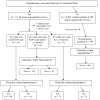The positive predictive value of a hyperkalemia diagnosis in automated health care data
- PMID: 20878650
- PMCID: PMC2996391
- DOI: 10.1002/pds.2030
The positive predictive value of a hyperkalemia diagnosis in automated health care data
Abstract
Purpose: Our objectives were to determine performance of coded hyperkalemia diagnosis at identifying (1) clinically evident hyperkalemia and (2) serum potassium>6 mmol/L.
Methods: This retrospective observational study included 8722 patients with diabetes within an integrated healthcare system who newly initiated an angiotensin converting enzyme inhibitor, angiotensin receptor blocker, or spironolactone. The primary outcome was first hyperkalemia-associated event (hospitalization, emergency department visit or death within 24 hours of coded diagnosis and/or potassium≥6 mmol/L) during the first year of therapy. Medical records were reviewed.
Results: Among a random sample of 99 patients not coded as having hyperkalemia, none had hyperkalemia upon record review. Among all 64 patients identified as having hyperkalemia, all had hospitalization or emergency department visit associated with coded diagnosis or elevated potassium. Of 55 with coded diagnosis, 42 (PPV 76%) had clinically evident hyperkalemia; 32 (PPV 58%) had potassium≥6. Of 9 identified using only potassium≥6, 7 (PPV 78%) had clinically evident hyperkalemia.
Conclusions: Nearly one-fourth of patients with coded diagnosis do not have clinically evident hyperkalemia and nearly one-half do not have potassium≥6. Because both false positives and negatives occur with coded diagnoses, medical record validation of hyperkalemia-associated outcomes is necessary.
Copyright © 2010 John Wiley & Sons, Ltd.
Figures
Similar articles
-
Diabetes and drug-associated hyperkalemia: effect of potassium monitoring.J Gen Intern Med. 2010 Apr;25(4):326-33. doi: 10.1007/s11606-009-1228-x. Epub 2010 Jan 20. J Gen Intern Med. 2010. PMID: 20087674 Free PMC article.
-
Predictors for repeated hyperkalemia and potassium trajectories in high-risk patients - A population-based cohort study.PLoS One. 2019 Jun 21;14(6):e0218739. doi: 10.1371/journal.pone.0218739. eCollection 2019. PLoS One. 2019. PMID: 31226134 Free PMC article.
-
Prevalence of hyperkalemia in adult patients taking spironolactone and angiotensin converting enzyme inhibitors or angiotensin receptor blockers.J Med Assoc Thai. 2013 Aug;96(8):905-10. J Med Assoc Thai. 2013. PMID: 23991595
-
Potassium-Binding Agents to Facilitate Renin-Angiotensin-Aldosterone System Inhibitor Therapy.Ann Pharmacother. 2016 Jun;50(6):502-10. doi: 10.1177/1060028016640794. Epub 2016 Mar 23. Ann Pharmacother. 2016. PMID: 27009290 Review.
-
New Therapeutic Approaches for the Treatment of Hyperkalemia in Patients Treated with Renin-Angiotensin-Aldosterone System Inhibitors.Cardiovasc Drugs Ther. 2018 Feb;32(1):99-119. doi: 10.1007/s10557-017-6767-5. Cardiovasc Drugs Ther. 2018. PMID: 29372448 Review.
Cited by
-
Longitudinal Data Discontinuity in Electronic Health Records and Consequences for Medication Effectiveness Studies.Clin Pharmacol Ther. 2022 Jan;111(1):243-251. doi: 10.1002/cpt.2400. Epub 2021 Sep 20. Clin Pharmacol Ther. 2022. PMID: 34424534 Free PMC article.
-
Incidence of and Risk Factors for Severe Adverse Events in Elderly Patients Taking Angiotensin-Converting Enzyme Inhibitors or Angiotensin II Receptor Blockers after an Acute Myocardial Infarction.Pharmacotherapy. 2018 Jan;38(1):29-41. doi: 10.1002/phar.2051. Epub 2017 Dec 11. Pharmacotherapy. 2018. PMID: 29059475 Free PMC article.
-
Sociodemographic characteristics of members of a large, integrated health care system: comparison with US Census Bureau data.Perm J. 2012 Summer;16(3):37-41. doi: 10.7812/TPP/12-031. Perm J. 2012. PMID: 23012597 Free PMC article.
-
Validity of the International Classification of Diseases 10th revision code for hyperkalaemia in elderly patients at presentation to an emergency department and at hospital admission.BMJ Open. 2012 Dec 28;2(6):e002011. doi: 10.1136/bmjopen-2012-002011. Print 2012. BMJ Open. 2012. PMID: 23274674 Free PMC article.
References
-
- Palmer BF. Angiotensin-converting enzyme inhibitors and angiotensin receptor blockers: what to do if the serum creatinine and/or serum potassium concentration rises. Nephrol Dial Transplant. 2003;18:1973–1975. - PubMed
-
- Palmer BF. Managing hyperkalemia caused by inhibitors of the renin-angiotensin-aldosterone system. N Engl J Med. 2004;351:585–592. - PubMed
-
- Juurlink DN, Mamdani MM, Lee DS, et al. Rates of hyperkalemia after publication of the randomized aldactone evaluation study. N Engl J Med. 2004;351:543–551. - PubMed
-
- Ahuja TS, Freeman D, Jr, Mahnken JD, Agraharkar M, Siddiqui M, Memon A. Predictors of the development of hyperkalemia in patients using angiotensin-converting enzyme inhibitors. Am J Nephrol. 2000;20(4):268–272. - PubMed
-
- Desai AS, Swedberg K, McMurray JJV, et al. Incidence and predictors of hyperkalemia in patients with heart failure: An analysis of the CHARM program. J Am Coll Cardiol. 2007;50(20):1959–1966. - PubMed
Publication types
MeSH terms
Substances
Grants and funding
LinkOut - more resources
Full Text Sources
Medical


